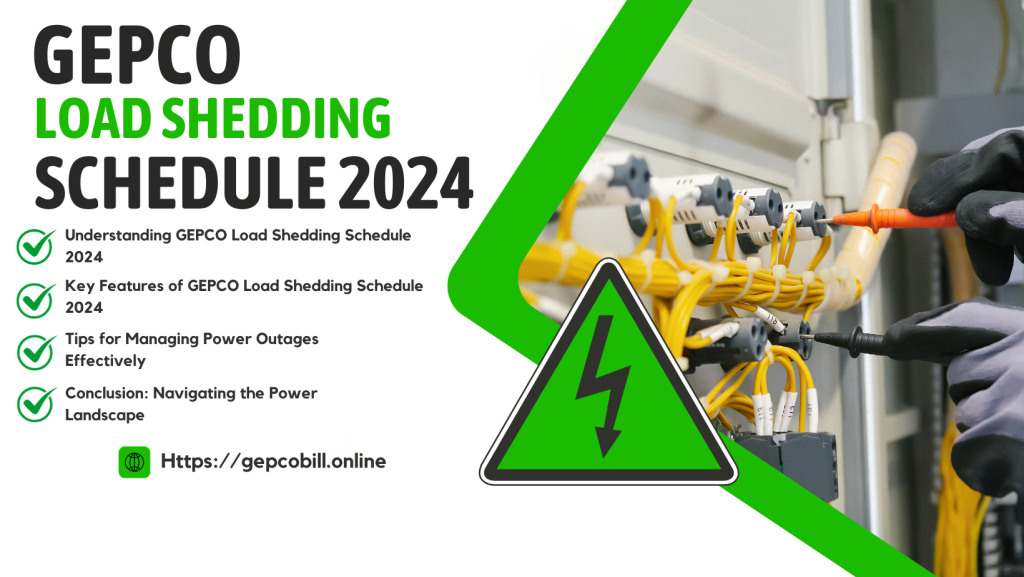Power outages, unfortunately, are a reality in many parts of the world. In Pakistan, the Gujranwala Electric Power Company (GEPCO) plays a crucial role in supplying electricity to the region.
To help residents cope with the challenges posed by load shedding, it’s essential to understand the GEPCO Load Shedding Schedule for 2024 and adopt effective strategies for managing power outages.
This guide aims to provide comprehensive information on the load-shedding schedule and offer practical tips to make the experience of power shortages more bearable.

Understanding GEPCO Load Shedding Schedule 2024
Load shedding is a strategy power companies use to manage the demand for electricity during periods of high usage.
GEPCO, responsible for providing electricity to a significant part of Punjab, including Gujranwala, Sialkot, and other nearby areas, follows a load-shedding schedule to distribute power cuts fairly among consumers.
The schedule is designed to minimize the impact on daily life while ensuring sustainable and equitable electricity distribution.
Key Features of GEPCO Load Shedding Schedule 2024
Time-Based Segments
The load-shedding schedule is typically divided into time-based segments, with specific hours allocated for power cuts in different areas. This segmentation allows consumers to anticipate and plan for outages during specific day periods.
Rotational Approach
Load shedding operates on a rotational basis, meaning that different areas experience power cuts at different times. This ensures that no single area bears the brunt of the outages consistently.
Notification Channels
GEPCO communicates the load-shedding schedule through various channels, including official announcements, online platforms, and local media. Staying informed about the schedule is crucial for residents to plan their activities accordingly.
Revision Possibilities
Load-shedding schedules can be subject to revision based on changes in electricity demand, technical issues, or improvements in the power supply situation. Consumers should stay updated on any changes communicated by GEPCO.
Tips for Managing Power Outages Effectively
While the load-shedding schedule provides a framework for anticipating power cuts, managing power outages effectively involves adopting certain practices and using resources wisely. Here are some practical tips to help residents navigate through periods of load shedding
Create a Power Outage Survival Kit
- Assemble essential items such as flashlights, candles, batteries, and a battery-powered radio to stay informed during outages.
- Keep a supply of non-perishable food items that don’t require cooking.
- Charge mobile phones and other electronic devices whenever electricity is available to ensure communication during outages.
Prioritize Energy-Efficient Appliances
- Invest in energy-efficient appliances, as they consume less electricity and can help minimize the impact of power cuts.
- Consider using LED bulbs, which are energy-efficient and provide longer-lasting illumination during outages.
Unplug Non-Essential Devices
- Unplug electronic devices and chargers when not in use to prevent unnecessary energy consumption.
- This practice conserves electricity and reduces the risk of damage to devices during power surges when the electricity is restored.
Optimize Cooling Solutions
- Use energy-efficient fans and air conditioners sparingly and only when necessary during hot weather.
- Consider alternative cooling methods such as using handheld fans, taking cool showers, or spending time in naturally ventilated areas.
Utilize Backup Power Sources
- Invest in backup power sources such as uninterruptible power supply (UPS) devices or generators for critical appliances and devices.
- Be mindful of safety precautions when using generators, ensuring proper ventilation and adherence to operational guidelines.
Plan Daily Activities
- Align your daily activities with the load-shedding schedule, focusing on essential tasks during periods of uninterrupted power.
- Use power-intensive appliances, such as washing machines and irons, when electricity is available to make the most of these windows.
Community Collaboration
- Collaborate with neighbours and community members to share resources and information about the load-shedding schedule.
- Community initiatives can include setting up shared charging stations or organizing collective efforts to address common challenges.
Stay Informed
- Regularly check GEPCO’s official channels for updates or changes to the load-shedding schedule.
- Stay connected with local news sources and community forums to receive timely information and share insights with fellow residents.
Energy Conservation Practices
- Practice energy conservation habits, such as turning off lights and fans when leaving a room.
- Invest in energy-efficient appliances and consider the environmental impact of energy consumption.
Explore Renewable Energy Options
- Explore incorporating renewable energy sources like solar panels to supplement your electricity needs.
- While initial costs may be involved, the long-term benefits of reduced dependence on the grid can be significant.
Conclusion: Navigating the Power Landscape
While load shedding can be challenging, adopting a proactive approach and implementing effective strategies can help residents manage power outages more efficiently. Understanding the GEPCO Load Shedding Schedule for 2024 is a crucial step in this process, providing residents with the information needed to plan their activities and minimize disruptions.
By incorporating practical tips for managing power outages into daily life, residents can make the most of the resources available during load shedding periods. Each step contributes to a more resilient and adaptive approach to electricity shortages, from creating a power outage survival kit to prioritising energy-efficient appliances.
Community collaboration and individual efforts are vital in enhancing the collective ability to navigate the power landscape. By staying informed, practicing energy conservation, and exploring alternative energy sources, residents can contribute to a more sustainable and resilient power ecosystem in the long run.
As we face the challenges of load shedding, let us also explore opportunities to embrace energy-efficient practices and technologies for a brighter and more empowered future.